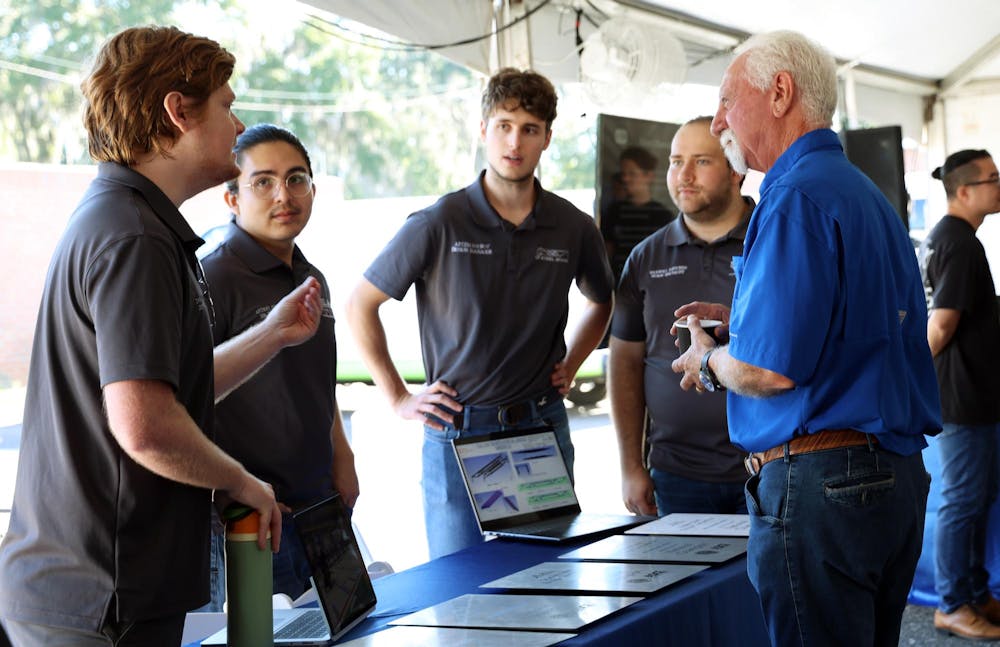From solving basic math equations to diving into the unknown world of artificial intelligence, the HiPerGator 4.0 offers answers to any question — efficiently.
The fourth generation of the fastest university-owned supercomputer in the U.S. was unveiled Tuesday during a ribbon-cutting ceremony on UF East Campus. The upgraded supercomputer, representing some of the newest AI technology, lets students compute higher amounts of data more quickly.
Students who have used the old HiPerGator model in research programs showed off their work at the event. Some had used the supercomputer for tasks like running simulations to help build race cars and launching rockets.
Chris Malachowsky, a UF alumnus and the co-founder of computer graphics company Nvidia, gifted the AI supercomputer to the university in early 2020. He helped fit and build the newest version.
AI is a fast-moving technology, Malachowsky said, and HiPerGator 4.0 is tuned for today's workload with a capacity exceeding its predecessor’s. It demonstrates UF's commitment to being a leader in the AI space, he said.
“It’s going to help the university attract the best and the brightest in terms of faculty, researchers, students, business collaborations, and it's going to help the state add value to its citizens,” Malachowsky said.
UF Board of Trustees Chair Mori Hosseini and Interim President Donald Landry attended the ribbon cutting alongside Malachowsky. Each spoke about the importance of the HiPerGator to a crowd dominated by UF administration members, with a smattering of students attending as guest presenters.

UF Interim President Donald Landry (left) sits next to Nvidia co-founder Chris Malachowsky (right) during the unveiling ceremony of the fourth generation of HiPerGator, the most powerful university-owned supercomputer in the U.S., at UF East Campus on Tuesday, Oct. 14, 2025.
The HiPerGator was created in 2013. To fund its newest update, the Board of Trustees allocated $24 million in December 2024 toward the supercomputer.
The HiPerGator ranked second on the Green500 list of the world's most energy efficient supercomputers in June 2021. By June 2024, its ranking plummeted to No. 33.
The latest version of the computer is about seven to 10 times faster than its previous version while using the same amount of energy, its directors say, meaning it will not be any worse for the environment.
The supercomputer is separated into the HiPerGator and HiPerGator AI. Each system has distinct roles. While the HiPerGator supports research and computation, HiPerGator AI focuses on artificial intelligence and machine learning. Recently, UF has used the supercomputer to aid in its efforts to find more efficient ways to create semiconductor chips, which are the foundation for most modern day electronics.
Azra Bihorac, a UF professor of medicine and senior associate dean of the UF Office of Research, uses the HiPerGator in her research about applying AI to improve medical care.
The HiPerGator helped her build a tool used behind the scenes before surgery, Bihorac said. When a patient comes before surgery, the AI tool automatically understands their preexisting conditions, the vulnerabilities they may have and risks of surgery having complications.
The amount of computation needed for research now is much higher than it was 10 years ago when she started, she said. She added researchers are putting dense data through the computer, such as videos and pictures, which makes it a harder computational task that requires a powerful machine like the HiPerGator 4.0.
“The ingredients are data, computer and people,” Bihorac said. “We have incredible talent, incredible computers and really incredible data. There is nothing stopping us from being the best, especially for AI.”
The supercomputer is stored at UF’s East Campus, in an area that spans 25,000 square feet and looks like a normal UF building, with windows and brick.
The building’s inside is not as normal. The computer is monitored 24/7 in case of issues, and visitors must wear protective headphones when inside the facility. The supercomputer produces 115 decibels of white noise — as loud as a jet engine or loud rock concert.

Erik Deumens, director of research computing in UF Information Technology, guides members of the media through “the bunker,” the housing facility for the computers that make up the fourth generation of HiPerGator, the most powerful university-owned supercomputer in the U.S., at UF East Campus on Tuesday, Oct. 14, 2025.
Erik Deumens, the director of the department of research computing in UF Information Technology, said the supercomputer allows faculty and students to access the latest technology.
“It’s the thing that's going to define us for the next two or three years,” he said of HiPerGator.
The new version is made of Nvidia’s latest technology, and it has been designed to focus on the next generation of AI training and capabilities, Deumens said. The HiPerGator 4.0 will also be used for simulations and modeling.
Lindsey Blaskowski, a 21-year-old UF mechanical engineering junior and Lucja Stawikowska, a 20-year-old UF mechanical engineering junior, are part of the UF formula team, Gator Motorsports. They use the HiPerGator to help with aerodynamic simulations and computations for car races.
“Without being able to use these kinds of computational services, we wouldn’t be able to get through our year and have the car running right now,” Stawikowska said.
Blaskowski said the team could use HiPerGator 4.0 for even larger simulations than they’ve been able to do in the past.
“It’ll be really interesting to see how it helps us to develop our team further,” Blaskowski said.
Contact Madeline Herring at mherring@alligator.org. Follow her on X @m_herring06.

Madeline is a first-year journalism and environmental science double major and the Fall 2025 general assignment reporter. In her free time she enjoys reading, binging new television series, and browsing the isles of target with her friends.






